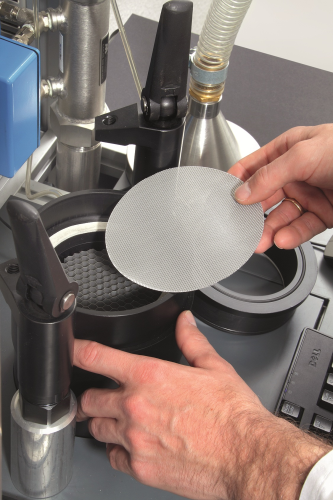
Automatic pressure drop test-station for measuring
air through-flow.
When it comes to industrial filtration, Haver & Boecker’s Minimesh has always been at the cutting edge. The company started weaving wire mesh in 1887 and by 1954 it was being used for applications in space with NASA’s aviation and aerospace programme.
At the time Haver & Boecker had developed Minimesh filter cloths which offered a previously unattainable level of filter fineness enabling smoothly functioning control systems and engine units. The wire mesh was used in all Apollo flights, proved itself in the Space Shuttle and continues to be employed in civil aviation to this day.
Now Haver & Boecker has developed a new generation of filter weaves, the Minimesh S Metal Filter Cloth. The company says the new product has been designed to make industrial filtration faster, more reliable and more efficient thanks to the continuing evolution of woven metal fabric technology.
Innovation is driven by customers wanting the highest degree of filtration, so that means having as small a pore size as possible. But this requires more energy to push the material through the media which is costly. Haver & Boecker products allow an increased flow capacity thanks to a research and development programme. The result is a sharp cut point of the mesh, better through-put and greater energy efficiency.
Determining permeability by using air flow measurement.
Specific properties
Compared to other filter media, the specific properties of woven wire mesh can be precisely described geometrically and defined through the type of weave, wire diameter and mesh count. For the user and manufacturer of woven wire filters, this is a considerable advantage because geometric pore size and permeability can be precisely calculated without the need for exhaustive measuring methods.
A characteristic value is determined for the geometric pore and describes the diameter of a round sphere that is just able to pass through the wire mesh. The pressure drop coefficient for air in laminar flow is used for determining permeability. The mathematical formulae behind this process were developed in co-operation with the University of Stuttgart and validated by glass bead tests and air flow-through measurements. These calculation processes now enable new filter elements to be designed beforehand, in accordance with the requirements of the user.
This means woven filter cloth can be immediately manufactured for a specific application without having to conduct time-consuming and costly trials. Known pore size evaluation methods were incorporated to validate the mathematical formula. The glass bead test indicated the maximum pore size (filter cut point) and the bubble point test gave qualitative assurance of the weaving process.
Other methods used include the air flow-through measurement (which measures the pressure difference as a function of flow-through speed), determination of fractional separation efficiency, contamination retention capacity and measured cleaning behavior.
Minimesh S metal filter cloths are weaved using wire threads from 15 microns to 12.5 mm. They are available in a wide range of pore sizes and have been certified by the testing institute Whitehouse Scientific. Their geometry and so filter structure, is absolutely uniform over their entire surface when compared to filter materials made of paper, plastic, or metal. Haver & Boecker say they have high mechanical strength, good temperature resistance, wettability and are highly resistant to chemical and physical influences.
Special alloys
The weaves are predominantly made from stainless steel but, depending on filtration requirements, special alloys can be used whenever they have the necessary metallurgical properties for extremely thin wires.
“Most production is from stainless steel. We also use copper, bronze, aluminium, special alloys and any metal that is durable depending upon application. Its products are used mainly in corrosive and abrasive environments because of its resistance capabilities,” said Friedrich Edelmeier, vice president of sales.
The company also fabricates parts and components from weave structures which give added value. These range from basic sieving and separation components to applications in the chemical, pharmaceutical, electronic, medical, automotive and aerospace sectors. They also have printing and architectural applications.
For example, the Minimesh DTW has applications including water processing and the filtration of blood plasma, while the Minimesh TRD can be used for the extrusion of plastics and in oil exploration. “Because the products are used across many industries, there is always a market should one industry experience a recession,” added Mr Edelmeier.
Needless to say, competition in the filtration industry is intense. European manufacturers enjoy the benefits of location and quality, but are disadvantaged by labor costs and energy prices. But they must remain competitive with Asian producers, so they try to stay innovative, as they cannot compete on price. Mr Edelmeier says their strategy is to stay ahead using technology to provide customers with quality and precision and be cost-effective.




